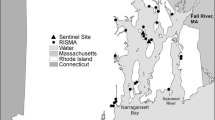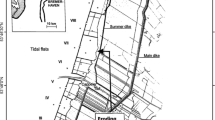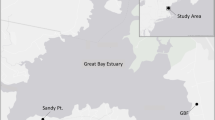Abstract
Changes in salt marsh vegetation were analyzed over a two-year period (November 1984–November 1986) following the construction of a dike in the southwest corner of Punta Banda Estuary, Baja California, México. Changes included: increased interstitial soil salinity, reduced soil moisture, increased mortality of Spartina foliosa and decreased middle marsh species diversity due to the elimination of annual and short-lived species. The sea-side edge of the middle marsh shifted its boundary to a lower elevation. By the end of 1986, dominant species were Salicornia virginica, Batis maritima and Frankenia grandifolia. By October 1988, only a few patches of S. foliosa persisted at the water edge, and it appeared that the community was not yet stable. The potential future of the estuary is evaluated.
Similar content being viewed by others
Literature cited
Brenchley-Jackson, J.L., Foin, T.C. and Zedler, J.B. 1987. Modelling the effect of salinity and inundation on Spartina and Salicornia in southern California. Proc. Soc. of Wetland Scientists. 8th Annual Meeting: 261–266.
Connell, J.H. and Sousa, W.P. 1983. On the evidence needed to judge stability or persistence. Amer. Nat. 121: 789–824.
Eilers, H.P. 1980. Ecology of a coastal salt marsh after long term absence of tidal fluctuation. Bull. Southern California Acad. Sci. 79: 55–64.
Ibarra-Obando, S.E. and Escofet, A. 1987. Industrial development effects on the ecology of a Pacific Mexican Estuary. Environ. Conserv. 14: 135–141.
Instituto Nacional de Estadistica, Geografia e Informática (INEGI). 1983. Estructura económica del Estado de Baja California, sistemas de cuentas nacionales de México. INEGI, SPP, México.
Kramer, G.W. and Migoya, R. 1989. The Pacific Coast of Mexico. In: Habitat Management for Migrating and Wintering Waterfowl in North America. pp. 507–530. Edited by L.M. Smith, R.L. Pederson and R.M. Kaminski. Texas Tec. Univ. Press, Lubbock, Texas.
Zedler, J.B. 1982. The ecology of southern California coastal salt marshes: a community profile. U.S. Fish and Wildlife Service, Office of Biological Services. FWS/OBS-8154. Washington, DC. 110 pp.
Zedler, J.B. 1983. Freshwater impacts in normally hypersaline marshes. Estuaries 6: 346–355.
Zedler, J.B. and Beare, P.A. 1987. Temporal variability of salt marsh vegetation: the role of low salinity gaps and environmental stress. In: Estuarine Variability. Edited by D.A. Wolfe. pp. 295–306. Academic Press, New York.
Zedler, J.B. and Nordby, C.S. 1986. The ecology of Tijuana Estuary, California: an estuarine profile. U.S. Fish and Wildl. Serv. Biol. Rep. 85 (7.5). Washington, DC.
Zedler, J.B., Covin, J., Nordby, C., Williams, P. and Boland, J. 1986. Catastrophic events reveal the dynamic nature of salt-marsh vegetation in southern California. Estuaries 9: 75–80.
Author information
Authors and Affiliations
Rights and permissions
About this article
Cite this article
Ibarra-Obando, S.E., Poumian-Tapia, M. The effect of tidal exclusion on salt marsh vegetation in Baja California, México. Wetlands Ecol Manage 1, 131–148 (1991). https://doi.org/10.1007/BF00177288
Issue Date:
DOI: https://doi.org/10.1007/BF00177288




